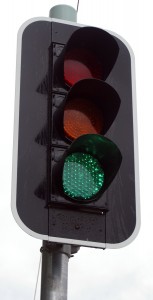Capital’s Traffic Lights Change To LED
Posted by Amit Soni on 2nd Sep 2011

They’ve long been a feature of our highways and byways, but did you know that traffic lights changed recently, and not in the way you’re thinking?
Yes, traffic lights in London and across the UK are now successfully utilising energy-efficient LEDs (Light-Emitting Diodes) to control the ever-increasing number of road-users.
In 2014, following years of consultation, new pan-London contracts saw traffic lights switched from wasteful incandescent bulbs to the latest environmentally friendly LED lighting technology, delivering significant savings to London, which were then filtered down to the London boroughs to be reinvested.
The traffic signal maintenance contracts, awarded by Transport for London (TfL), were worth in the region of £317 million, and their advent marked the beginning of the huge upgrade of the capital's 6,200 traffic signals to cost-efficient LEDs.
Dana Skelley, TfL’s Director of Asset Management, who was honoured with an OBE a year later, said "London is world-leading when it comes to traffic signals management and these new contracts will allow us to continue this well into the future."
At the time the contracts were agreed just 13% of the Capital’s traffic lights used energy-efficient LEDs, however, in the two years since then and in the years to come TfL is working to expand this to 100%.
This was the largest project of its type at the time, and promised to reduce the city's electricity consumption by up to 60 per cent.
To put the energy savings for London into perspective, LED traffic lights generally use between 9 and 25 watts of electricity, compared to the 75 to 150 watts used by an incandescent signal.
Therefore, assuming a cost of 6.5 pence per kWh, converting just 100 red signals to LEDs would save approximately £2,100 every year so, extrapolated up to include London’s 18,600 individual red, amber and green traffic lights, the savings would be a staggering £400,000 per year.
Conventional traffic lights used to be changed once a year, but with the new LED lighting with its average 50,000 hour life-expectancy in place, changes would only be necessary once a decade, dramatically cutting down on maintenance costs.
This bulb-longevity results in a much smaller carbon footprint. This in turn extrapolates to an approximate 9,500 tonne reduction in carbon emissions, which is about the same weight as 812 London double-decker buses!
Since the big switch to LED traffic lights in London, other councils, such as Lincolnshire have also upgraded theirs as well, resulting in an energy saving of £60,000 in the first year!
If you’d like to emulate some of these colossal savings, albeit on a somewhat smaller scale, why not consider replacing your traditional incandescent and fluorescent lights with cost-effective LEDs?
You’ll discover an amazing range of LED lighting products with which you’ll be able to achieve some incredible savings, including a selection of outdoor motion sensor LED floodlights, as well as RGBW LED strip lights that will duplicate a traffic light’s colours to perfection!





